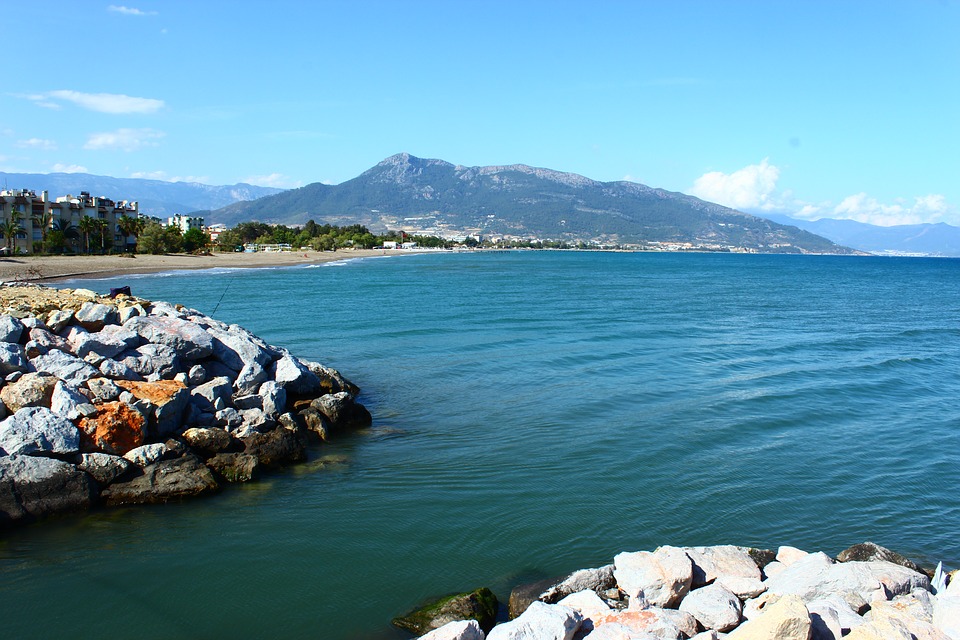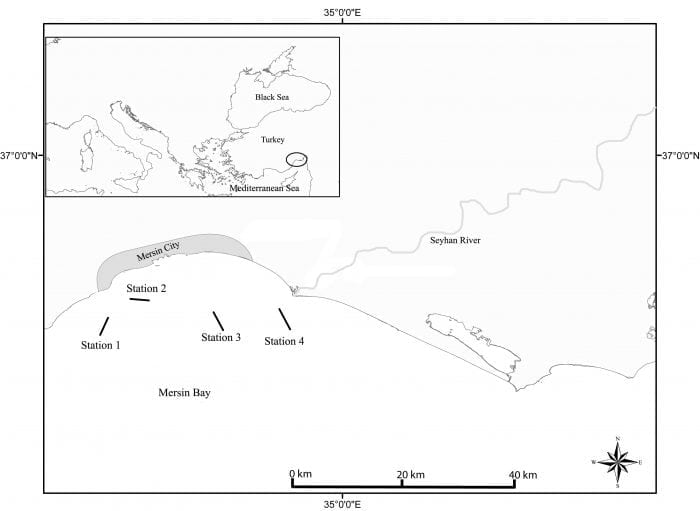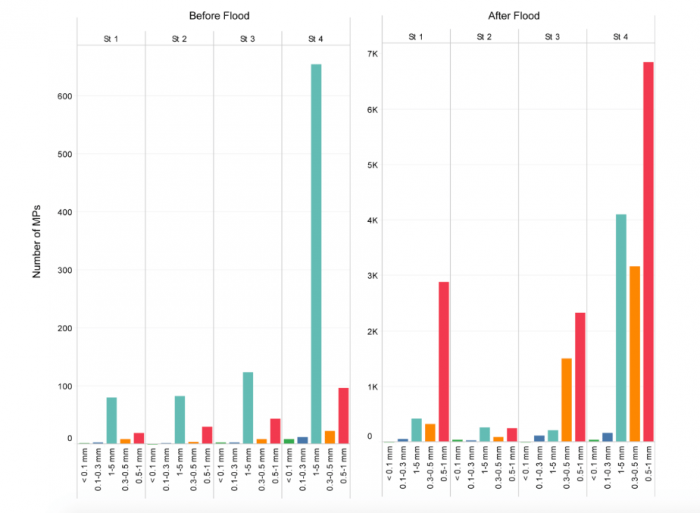
Heavy rains that began on December 20, 2016, caused severe flooding in the province of Mersin, southern Turkey, on December 29, 2016. Two people died and many were wounded as a result. The flood increased the amount of microplastics pollution in Mersin Bay by 14 times.
It is widely known that climate change has a negative impact on life in many ways. In particular, catastrophic floods following heavy rains that are caused by climate change introduce a significant amount of anthropogenic stressors to aquatic ecosystems.
As we all know, plastics are one of the most unwanted anthropogenic stressors. However, we do not think that there can be a relationship between global climate change and plastics pollution. When someone talks about global climate change, the first things that come to mind are drought, melting glaciers, and, of course, polar bears, not plastic pollution.
The link between climate change and plastic pollution is based on some basic principles: cause and effect! If there is deforestation, unplanned urbanization, and inadequate infrastructure, excessive rainfall can cause flooding. Sure, floods can occur even if everything is properly done. But, this is not really related to the topic of this article.
A flood is an overflow of water that submerges land which is generally dry and carries materials (micro or macro) uncontrollably from one point to another. And plastics form a great part of these materials.
We clearly observed this phenomenon during the examination of consequences of excessive rainfall which affected the northeastern Mediterranean coast of Turkey (especially Mersin) between December 2016 and January 2017.
Now is the time to say some words about the size and causes of the flood.
The Mersin province has undergone a rapid population growth due to internal migration within the last 30 years. Rapid population growth has brought the problems of unplanned urbanization. The distorted infrastructure, which occurs in connection with unplanned urbanization, can lead to floods during any rainfall, not necessarily heavy rains.
Floods invite dramatic consequences. The flood that occurred on December 29, 2016, in the province of Mersin is a perfect example of these dramatic results. Heavy rain that started on December 20 caused severe flooding in Mersin. It is reported that two people died and many were wounded as a result.
The heavy rains that started on December 21-22, 2016 continued until January 1, 2017, and a total of 346.8 kg/m2 rainfall occurred within those 9 days. Mersin has a long-term rainfall average of 129.8 kg/m2 in December and a long average annual rainfall of 579.7 kg/m2. These figures show that with those 9 days, Mersin received 60% more rain than typical annual expectations! This inevitably led to a disaster.
This level of rain and the subsequent disaster not only caused damage to the terrestrial environment but also affected the marine environment. Floods in coastal cities like Mersin carry things from terrestrial environment to sea. The fact that many pollutants including plastics were transported to the marine environment helps us establish a link between global climate change and plastic pollution.
The Mersin Bay could be called quite polluted, even before the floods carried polluters. Before the flood (November 2016), an average of 539,189 MPs/km2 particles were detected.

Figure 1: Map of study area. Credit: Sedat Gündoğdu
This was the third-highest microplastics (MPs) concentration in the Mediterranean Sea followed by Israeli coasts and Iskenderun Bay, again in Turkish waters. The flood has increased that value 14 times and made the Mersin Bay the most polluted region of the Mediterranean Sea, with a value of 7,699,716 MPs/km2. This situation supports the expression, “plastic soup,” that was previously used for the Mediterranean Sea.

Figure 2: Distribution of MP amounts between MP shapes at the four stations before and after the floods. Credit: Sedat Gündoğdu
Flooding can lead to an increase in the number of MPs as well as a decrease in the size of MPs. For example, the mean size of MPs measured in Mersin Bay before the flood was 2.37 mm, while it decreased to 1.13 mm post-flood. This has many negative effects. Smaller particles mean smaller organisms, such as fish larvae, mussel, and shrimp, can ingest these particles and transfer them into the food chain. As it stands, floods can make the plastic pollution problem even more complex.

Figure 3: MPs size distribution at the four stations before and after the floods. Credit: Sedat Gündoğdu
Serious agricultural activities are being carried out around Mersin Bay. Currently, plastic pollutants of agricultural origin in Turkey (mulching material, plastic greenhouse covers, irrigation pipes, pesticide bottles, etc.) pose a grave problem. In terrestrial areas, it is possible to see these pollutants in uncontrolled states. Floods can help transport these uncontrolled pollutants to the sea. In particular, polyethylene plastic films used as cover materials constitute a serious risk. The increase in the amount of polyethylene covering materials in Mersin Bay after the flood reveals that this risk is worse than initially thought.
Additionally, Ethylene/Methacrylic Acid Ionomer (EMA), Ethylene/Propylene Copolymer (EPC), Ethylene/Propylene/Diene Terpolymer (EPDT), Polyamide-6/Nylon-6 (PA-6), Phenoxy Resin (PR), and Poly (Styreneco-2-Acrylamido-2-Methyl Propane Sulfonic acid) (PSAMPSA)-type polymers that were not found before the flood were present afterwards, and PAAC and SAAC-type polymers that showed a significant increase post-flood were all polymers that are heavily used in electronics, medical equipment, food packaging, toys, construction materials, and similar industries. Debris caused by the flood itself and any loose plastic waste left in the land were carried by floods directly to marine environments, increasing the polymer variety of marine plastics.
Excessive rainfall and flood are results of global climate change, and plastic pollution is a result of excessive plastic consumption and unsustainable waste management. The reason for both of them is human behavior.
These findings show us that plastic pollution is a serious problem. What’s more, plastic pollution becomes unbearable when it is combined with other kinds of human activities.
These findings are described in the article entitled, How microplastics quantities increase with flood events? An example from Mersin Bay NE Levantine coast of Turkey, recently published in the journal Environmental Pollution. This work was conducted by S. Gündoğdu, C. Çevik, and S. Karaca from Cukurova University, and B. Ayat and B. Aydoğan from Yildiz Technical University.
Reference:
- Gündoğdu, S., Çevik, C., Ayat, B., Aydoğan, B., & Karaca, S. (2018). How microplastics quantities increase with flood events? An example from Mersin Bay NE Levantine coast of Turkey. Environmental Pollution, 239, 342-350.









